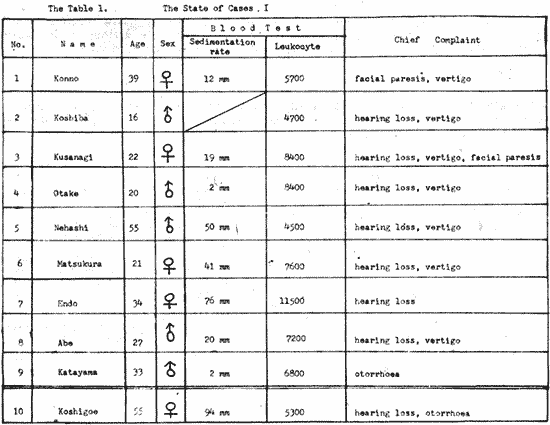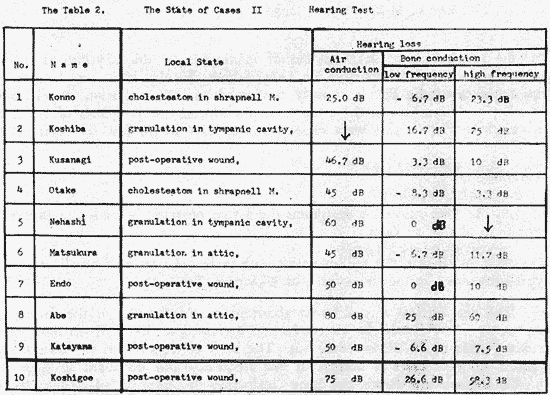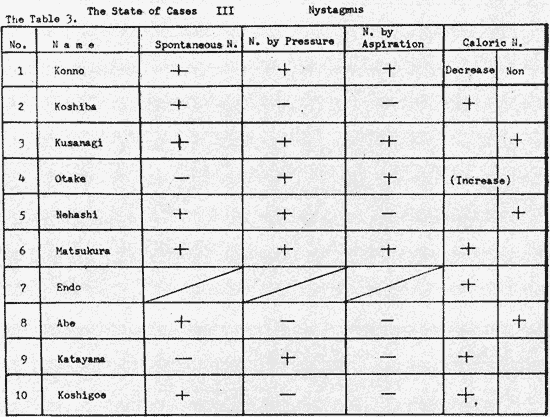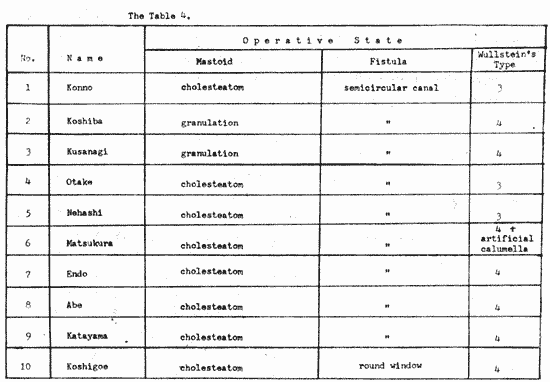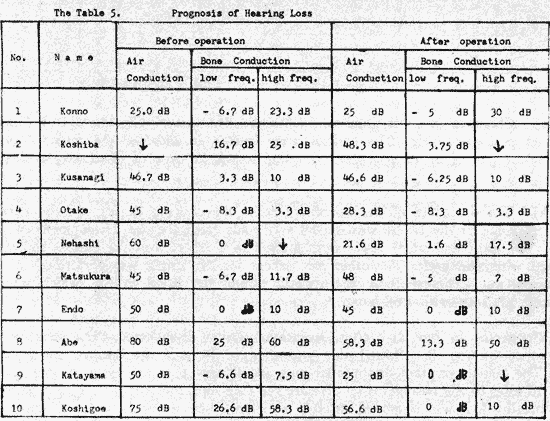

Ano: 1974 Vol. 40 Ed. 2 - Maio - Dezembro - (57º)
Seção: Artigos Originais
Páginas: 329 a 333
Symptoms and Prognosis of Labyrinthine Fistula
Autor(es): T. Kamio, M. D. - Tokyo, Japan
![]()
For the prophylaxis of deafness and of meningitis by the labyrinthitis diffusa from the labyrinthitis circumscripta or Labyrinthine Fistula, it is very important, that the existence of the Fistula is early confirmed and the operation is performed quickly. The author mentions the symptoms, procedures, and prognosis of ten cases with labyrinthine Fistula, that were experienced by him in the last few years.
Symptoms:
1) As the chief subjective symptoms the author observed hearing loss, otorrhoea and vertigo in almost all cases.
2) As a blood test, the sedimentation rate increased over half of all cases, but the hyperleukocytosis is mostly normal, as shown in Table 1.
3) The hearing loss was different according to the location of the fistula; on the semicircular canal fistula the air conduction decreased to 40-60 dB in most cases, on window fistula to 70 dB - scare out. The bone conduction on the semicircular canal fistula of most cases is normal in low frequency and decreased in high frequency. On the window fistula the bone conduction decreased in all frequencies, as in Table 2.
4) About Nystagmus. Spontaneous nystagmus was observed in half of all cases, and beat towards the affected side. The nystagmus by pressure and aspiration; the fistula symptom was observed in most cases of the semicircular canal fistula but was not observed on the window fistula, as shown in Fig. 1, 2 and Table 3. The caloric nystagmus reaction of most cases was weak or none at all. 2 cases were without the fistula and only with the hyperdeveloped cell system, in spite of positive confirmation of the fistula symptom and similar subjective symptoms.
5) Cholesteatoma was observed in Mastoid of 9 cases. The mastoid of 2 cases occurred post-operatively. The ossicles were broken in most of the cases. 7 cases were taken care of by an operation according to the IV type of Wullstein, as shown in Table 4.
6) The procedure of the operation. After the clearing of part of the fistula, the bone edge of the fistula was shaved and made fresh for the development of the bone. The great and small fascia were grafted in 2 layers over the fistula, and then covered with skin graft. The other part except for the fistula was performed in the customary way. The especially big mastoid wound was filled with a pedicle muscle or fascia graft or with keel-tone.
Prognosis: In few days after operation, vertigo disappeared. The spontaneous nystagmus towards the affected side was changed towards the healthy side in few days. The fistula symptom disappeared with in 30 days after operation in most cases. Only in cases of the nystagmus by pressure the cure took sometimes in 2 or 3 months. The hearing loss was improved on the semicircular canal fistula and not improved on the window fistula, as shown in Table 5.
Summary:
When the vertigo is complicated in the chronic inflammation and cholesteatom, we have doubts about the labyrinthine fistula and perform the fistula symptom test. When the fistula symptom is positive, the fistula operation is performed quickly and carefully by Mastoidectomy and also is covered with the fascia and skin graft. When the fistula symptom test is negative, the test-opening is done. By quick processing after the occurrence of the labyrinthine fistula the prognosis is better, especially the hearing loss of the semicircular canal fistula is improved.
Abstract
Symptoms and prognosis of labyrinthine fistula were observed in a series of 10 patients, that were operated on the author's clinic during several years. 1) the location of the fistula; 9 cases were in the semicircular canal and 1 case in the round window. 2) 7 cases of the semicircular canal fistula complained of vertigo. 3) the hearing loss of the semicircular canal fistula was high grade in air conduction, and the bone conduction was almost fair in low frequency. The hearing loss of window fistula was stronger that in the former. 4) the spontaneous nystagmus was found in 7 cases. 5) the fistula-symptom was observed in 5 cases positively. 6) decreasing of the caloric nystagmus reaction was observed in most cases. 7) the closing of the fistula by the double transplantation of fascia, and the skin grafting was in most cases effective. 8) the hearing loss was improved in half cases after the tympanoplasty.
All rights reserved - 1933 /
2025
© - Associação Brasileira de Otorrinolaringologia e Cirurgia Cérvico Facial
